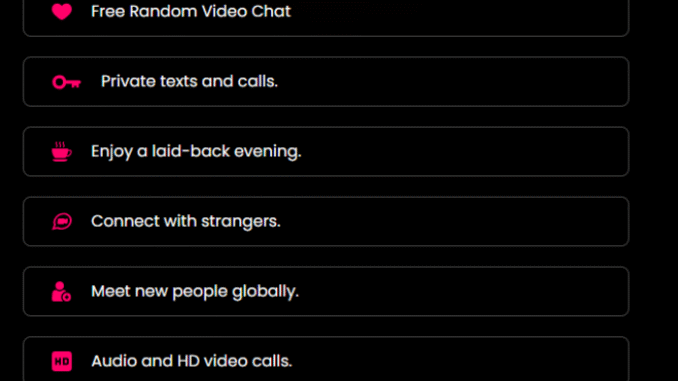

When “Talk to Strangers” Went Viral
In 2009, a 17-year-old student named Leif K-Brooks launched a simple idea: pair two strangers by webcam and let them talk.
He called it Omegle, and within weeks millions were hooked.
It felt electric – spontaneous, global, and delightfully unpredictable.
But what started as digital serendipity quickly spiralled.
With no moderation, Omegle became infamous for explicit content and trolling.
A generation learned a hard truth: pure randomness online, without structure or safety, can turn toxic fast.
By 2023, after years of legal pressure and rising moderation costs, Omegle finally shut down.
Its farewell message read like an obituary for a lost dream – the hope that technology could connect the world through curiosity alone.
Why Random Still Matters
Despite its flaws, Omegle revealed something profound about human nature: people want to talk to strangers.
In a hyper-curated internet where algorithms decide what we see and who we meet, genuine randomness feels almost rebellious.
Sociologists call this the “serendipity effect” – those small, unplanned encounters that spark empathy, creativity, and joy.
And in 2025, that impulse is resurfacing, only this time with structure, safety, and intelligence.
Random video chat isn’t dead; it’s evolving.
The Three Eras of Random Connection
1. The Wild West (2009–2015)
Omegle and Chatroulette dominated this phase – thrilling but chaotic.
They offered instant access to anyone, anywhere, but with no guardrails.
The novelty was unmatched, but so were the risks.
2. The Age of Filters (2015–2021)
As safety scandals mounted, the pendulum swung too far the other way.
Social networks introduced rigid identity verification and content filtering, but spontaneity vanished.
“Meeting new people” online started to feel like filling out paperwork.
3. The AI Era (2022–present)
Enter the new generation – platforms using AI-driven moderation and matching to recreate the magic of early random chat while protecting users from its downsides.
Here, technology doesn’t replace humanity; it enables it.
How AI Is Making Random Chat Smarter
Modern systems use a mix of computer vision, natural-language understanding, and behavioural analytics to make real-time moderation possible.
Take the VideoModerator framework (Tang et al., 2021): it analyses multiple signals – audio, video, and text – simultaneously to detect nudity, violence, or harassment within milliseconds.
These innovations laid the foundation for safer, cleaner, more respectful random-chat environments.
AI now acts as a digital bouncer and matchmaker in one – quietly filtering bad behaviour while guiding compatible users toward each other.
Enter Thundr – Random, Reimagined
Among the new wave of platforms, Thundr stands out as the clearest expression of this evolution.
It keeps the spirit of randomness alive – you never know who you’ll meet – but pairs it with machine-learning intelligence that shapes better interactions.
Thundr’s system uses three key layers of AI:
- Interest-based matching: semantic algorithms identify shared topics, hobbies, or moods before connecting users.
- Real-time safety scanning: multimodal AI models flag explicit visuals or abusive language instantly, not after the fact.
- Privacy by design: on-device moderation ensures that conversations stay ephemeral and unrecorded.
The result feels less like roulette and more like serendipity – natural, safe, and genuinely fun.
Beyond Safety: Building Digital Empathy
AI moderation isn’t just about blocking bad content; it’s about enabling good conversation.
When users feel safe, they’re more open – and that’s when real connection happens.
A 2024 Pew Research Center study on digital wellbeing found that meaningful one-to-one online conversations reduce self-reported loneliness and increase cross-cultural understanding.
In that sense, platforms like Thundr aren’t just fixing Omegle’s problems; they’re addressing the internet’s deeper one – isolation.
By combining randomness with responsibility, they turn chance encounters into small acts of global empathy.
The Design Philosophy: Chaos with Compassion
Older platforms chased virality.
The new generation chases quality.
Features like session time limits, interest tags, and subtle UX prompts encourage curiosity over shock value.
As The Verge observed in its coverage of Omegle’s closure, the internet is moving toward “smaller, safer, more intentional spaces.”
Thundr embodies that shift – less spectacle, more substance.
You don’t scroll. You don’t perform. You just talk.
The Broader Shift: From Algorithmic Feeds to Human Feeds
Every major tech trend points the same way: people want presence, not performance.
Podcasting, group video chats, live audio rooms – all signal a collective craving for unfiltered human contact.
Random video chat is simply the purest form of that impulse: two people, one moment, zero agenda.
And with AI quietly removing the friction – language barriers, safety issues, awkward silences – it’s becoming one of the most surprisingly hopeful technologies of the decade.
From Chaos to Connection
Omegle’s story ended where Thundr’s begins.
What started as teenage chaos has matured into something thoughtful – an experiment in what happens when technology helps us rediscover humanity.
The randomness is still there, but it’s directed randomness – guided by design, protected by AI, and fuelled by curiosity.
The next time you open a random chat, you’re not stepping into chaos.
You’re stepping into the evolved internet – one conversation at a time.
Leave a Reply